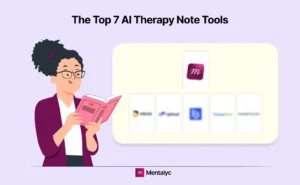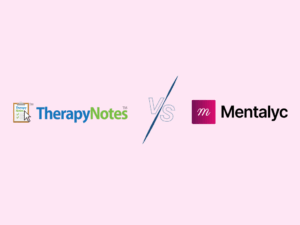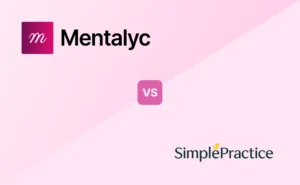If you’re a mental health professional, you may feel overwhelmed with all the different types of mental health notes. You might wonder what types of notes you have to write, what types of notes can be helpful to you, or what all the different acronyms in note templates stand for.
Knowing that you’re providing sufficient information can be challenging when documenting client sessions. The different types of notes can become overwhelming and stressful. As a result, it can be easy to fall behind on documentation, especially when you don’t know your options.
If this sounds like you, don’t worry! Mentalyc has got you covered. With this complete all-in-one note-taking solution for therapists, you can now create therapy progress notes within two minutes.
Now let’s explore some different types of note formats, types of notes, and what situations you might have to enter other types of documentation.

New! Transfer your notes to EHR with a single click. No more copy-pasting.
Case Notes
Case notes include all types of documentation in a client’s chart. Case notes help you record relevant information about your client and are essential for billing insurance. Case notes with a signed release of information form may also be released to third parties or other medical professionals. Therefore, your notes must be clear, concise, and readable to others.
Case records usually begin with an intake note.
Intake Note
When you write an intake note, you document background information about your client you gathered in the first few sessions. The intake note is often essential to set goals for the client’s treatment, create a treatment plan, and formulate a diagnosis.
Standard information to include in an intake note includes:
- Client name and date of birth
- Date, time, and location of the session
- Reasons the client is seeking therapy
- Previous therapy experiences
- Medical history
- Allergies
- Mental health symptoms
- Substance use history
- Trauma history
- Developmental history
- Cultural background
- Spiritual/religious background
- Strengths
- Support system
- Family history
- Hobbies and interests
- Employment history
- Educational background
Each therapist may include different sections in their intake note, but gathering background information in these areas may be essential for a plan of action. This action plan is the treatment plan, the following case note section.
Treatment Plan
Treatment plans determine a plan of action for the mental health professional and the client. The treatment plans help you target the client’s goals and are client-focused.
Some common examples of what to include in treatment plan documentation are:
- Client’s demographic information
- A summary of the client’s condition
- Client’s presenting symptoms
- Client’s diagnosis (if applicable)
- Client’s goals
- Objectives on the path to goals
- A timeframe for each listed goal or objective
- Client’s progress toward treatment
The treatment plan outlines the client’s treatment. Once the treatment plan is created, you will need to have a way to document each psychotherapy session through progress notes.
Progress notes
When you write a progress note, you document what occurred in each therapy session. You can choose a format that works best for you, as there are many options.
Some of the most common template formats for documenting progress notes include:
SOAP Notes
Soap notes are a popular note documentation format that includes four sections:
- Subjective-Client report of symptoms and presenting problem.
- Objective- Clinical observations of the client’s mood, appearance, and behavior in session.
- Assessment-Any assessments or diagnosis.
- Plan-Next steps of the client’s treatment
DAP Notes
DAP notes follow a specified format and are focused on the client.
DAP notes include three sections:
- Data-Anything the client reports during the session and observable symptoms
- Assessment- Therapist’s clinical judgment, diagnosis, and any evaluations or testing
- Plan- What happens next in the client’s treatment.
Most progress note formats include a plan section.
BIRP Notes
BIRP notes focus on the behavior(s) of the client in psychotherapy sessions.
BIRP notes have four sections:
- Behavior- what is happening with the client, what is the client reporting, what is the client exhibiting in session.
- Intervention-Anything the therapist does in session to help the client reach their treatment goals
- Response- How the client is responding to treatment
- Plan- Where will you go next in treatment, and are there other supports that would be helpful?
BIRP notes help you track your client’s behavior over time easily.
PIRP Notes
PIRP notes are problem-focused notes, which help you orient to treating the client’s problems. PIRP notes are similar to BIRP and GIRP notes.
PIRP notes have four sections:
- Problem- Recording the client’s reasons for being in therapy
- Intervention- How the therapist helps their client work towards their goals
- Response- How the client is responding to the therapist’s intervention or therapy
- Plan- Always outlines the next steps and what the focus will be
PIRP notes are beneficial for those who want to keep the challenges their clients are having in mind.
GIRP Notes
GIRP notes are goal-focused and help you easily focus on collective goals during the session.
GIRP notes have four sections:
- Goal- What the client wants to achieve in therapy
- Intervention- What the therapist does in response to the goal
- Response- How the client is responding to the treatment plan
- Plan- Focuses on where to go next
GIRP notes are beneficial for clinicians who are goal-focused in their sessions.
Custom Formats
Some therapists may not like the standard note formats and, therefore, may create their own according to their needs. The needs of the client may require customized progress notes. It’s up to the clinician to find a format that works for them.
Therapy type
The type of therapy may also determine how you document your sessions. You will need to consider how many participants are involved in treatment.
When you type progress notes, you need to consider these types of sessions:
- Individual Sessions
- Couples Sessions
- Family Sessions
- Group Sessions
Here are some tips for completing each type of note.
Individual sessions
In individual sessions, you focus on the therapist and client interactions.
For individual sessions, you might:
- Use a specified note format such as SOAP, BIRP, DAP, etc.
- Keep all records in the same place
- Focus on the progress of the client
You may consider using one note format with all clients.
Couples sessions
In couples’ sessions, you focus on the interactions between the couple and between the couple and the therapist.
For couple’s documentation, you might consider:
- Choosing whether have one chart for the couple or keep separate records
- Include the goals of both individuals in your documentation
- State something about the interactions and patterns you notice between the couple
Couples’ session notes don’t have to be complex if you are consistent in your documentation.
Family sessions
In family sessions, you document interactions between the whole family and not just individuals.
For family documentation, you might consider the following:
- Choosing what chart to document the family sessions in
- Writing the goals of each family member in your records
- Ensuring confidentiality if you are working with a family member individually
When writing family session notes, you may consider documenting the interactions and patterns you notice within the family dynamic.
Group Therapy
For group therapy sessions, you are documenting the participation of each individual and how they interacted with the group therapist and also how they interacted with other members of the group.
Some tips you might consider when noting group therapy sessions are:
- Documenting a group note and individual note.
- Focuses on group members’ interactions and participation
- Never use the full names of other clients in group documentation to ensure confidentiality
When you document a group session, you must be clear about what interventions and education you provide.
Modality-type notes
There are other situations in which documentation may look different than an individual note does. For example, if you are an EMDR-trained clinician, the format of your notes is different due to the differences that occur in EMDR therapy compared to talk therapy methods alone.
Eye movement desensitization and reprocessing therapy is an evidenced-based method for treating trauma.Typical sections of EMDR notes include:
- Presenting problem or memory
- Image
- Negative thought
- Positive thought
- Validity of thought
- Subjective units of distress
- Sensations in your body and their location
- Desensitization
As you can see, due to the differences with EMDR, the sections you document in a progress note are different than SOAP, BIRP, DAP, or other similar formats of progress notes.
Service Notes
Service notes are written to document other types of contact you may have with a psychotherapy client.
Some examples of when you might write service notes include:
- Client phone calls
- Contacting a person for collateral information (With a release of information signed)
- Documenting client contact outside of the session
Service notes may also be known as contact notes. In these notes, you can document any client e-mails or text messages you receive.
Service notes most often include:
- Date, time, and method of contact
- Purpose of contact
- How the therapist responded
Service notes document quick contact with clients outside of the session.
Follow-up Notes
If you plan to follow up with a client later as a mental health clinician, this may be considered a follow-up note.
You are checking in on a client to ensure their safety, check on how a significant event in their life went, or need to follow up with the client for some reason between their scheduled sessions.
In a follow-up note, you may also document the following:
- Date and time of follow-up
- What the client reported
- Any interventions you used
- Any additional referrals you provided
Follow-up notes document short follow-ups with the client.
Crisis Intervention Notes
If you have a client that requires crisis intervention, such as making a report of child abuse, or have to refer a client for hospitalization, you may have to write a crisis intervention note.
A crisis intervention note documents all necessary aspects of what occurred between you and the client.
Discharge/Clinical Summary Notes
A discharge/clinical summary note reviews the client’s progress in therapy. You write these notes at the end of a client’s treatment.
Discharge notes/clinical summaries should include the following:
- The times and dates of treatment
- Treatment goals
- Progress or obstacles toward goals
- Interventions
- Client response to interventions/progress in therapy
- Reasons for ending or discharging client from therapy
You provide an overview of your work in therapy with a documented reason why the treatment is ending.
Process Notes
Process notes benefit the clinician and aren’t part of the client’s official record. Instead, process notes are notes to yourself about what you may want to follow up on later. These notes are kept separate from the client’s record and, in rare cases, may still be subpoenaed if necessary.
Process notes don’t follow a specific format; they may include anything that may be helpful to you as a mental health professional. For example, a process note may be something you write in a separate area about a topic to bring up in supervision or a consultation group.
Recap of Mental Health Documentation
Mental health documentation usually includes intakes, treatment plans, and progress notes. What types of notes you write may differ in format, therapy type, and contact outside the therapy sessions. The process note is the only note that isn’t a part of the client’s official record. The process note is a note that is beneficial for the mental health professional only.
Disclaimer
All examples of mental health documentation are fictional and for informational purposes only.
Why other mental health professionals love Mentalyc

“It’s so quick and easy to do notes now … I used to stay late two hours to finish my notes. Now it’s a breeze.”
Licensed Professional Counselor

“Having Mentalyc take away some of the work from me has allowed me to be more present when I’m in session with clients … it took a lot of pressure off.”
LPC

“By the end of the day, usually by the end of the session, I have my documentation done. I have a thorough, comprehensive note … It’s just saving me hours every week.”
CDCII

“A lot of my clients love the functionality where I can send them a summary of what we addressed during the session, and they find it very helpful and enlightening.”
Therapist






